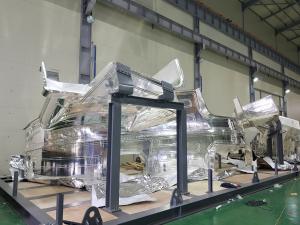Image of the week
The shine of silver
13 May 2019
All ITER components are precious. But some look more precious than others.
The vacuum vessel thermal shield comprises nine 40° sectors. Sector #6 is pictured here, ready to be packed and shipped to ITER.
A vacuum vessel sector, a toroidal field coil, a cryopump, or a divertor cassette are priceless pieces of high technology. But they could hardly pass for jewelry.
The thermal shield could. Because its mission is to protect the tokamak's superconducting coils from thermal radiation, it is coated with the most efficient of "low-emissivity" materials. And this material happens to be ... silver.
Given the size of the thermal shield (approximately 2,000 square metres), a 5- to 10-micrometre-thick silver plating on both sides requires no less than 5 tonnes¹ of the precious metal—enough to make 625,000 sterling silver rings.
A first finalized sector of the vacuum vessel thermal shield (sector #6) has left the SFA Engineering Corp in Changwon, Korea, to be delivered to ITER.
¹Five tonnes of silver will be required in the electroplating baths. The mass of silver coating the thermal shield panels is estimated at just under 800 kg total.


